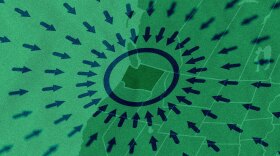Think of the immense amount of stuff in the cosmos: stars, planets, interstellar dust and clusters of galaxies. Now consider this: all that stuff is probably only about one-sixth of the matter in the universe.
The rest is thought to be a mysterious invisible substance called dark matter — something scientists have been hunting for decades. Now an unexpected turn of events has put a low-key research team in Seattle right at the center of the dark matter search.
The More They Saw, The More They Knew They Didn't See
The story goes back at least 80 years, when astronomers began to put together a contradiction. The more they saw, the clearer it became they weren’t seeing everything.
“There just wasn’t enough normal matter in the universe to account for the matter in the universe,” said University of Washington physics professor Leslie Rosenberg. “This was very odd. [It] took a long time for people to believe this.”
Galaxies spin, and they don’t seem to contain enough matter for gravity to hold them together. They should be flying apart all over the place, unless there’s some unseen substance mixed in, adding ballast.
Over the decades, other observations confirmed it: The universe is not made mostly of normal atoms, but some other thing. It must be something light doesn’t bounce off of, or else we’d be able to see it. (We’ll leave out dark energy, thought to be three times more abundant than both kinds of matter combined, because that stuff is even weirder.)
Discovering what makes up this dark matter is one of the most urgent unanswered questions in physics.
An Underdog Tale
This is kind of a Cinderella story – the story of a favorite and an underdog, in what may be the world’s most esoteric sport. The leading candidate for what might make up dark matter is called a weakly interacting massive particle, or WIMP. It gets most of the research money and most of the ink.
But there’s another candidate, a bit of an also-ran, called the axion. Its profile is lower, but for Rosenberg, it just seems to fit in with how the universe works.
“All these pieces put together, to me, make a pointillist painting that just comes into sharp focus. I looked at the evidence, and I could see axions in it,” he said.
Both WIMPs and axions, if they exist, would be hard to catch. But WIMPs should be just barely detectable in giant machines. So scientists got busy, but the first generation of detectors came up empty. They built bigger ones, and again the WIMPs eluded their grasp.
Over and over, the WIMP searchers searched, following little breadcrumbs of evidence. Just a few years ago, physicists were swearing we were right on the verge of solving the dark matter puzzle. But with some recent disappointing results, the WIMP’s prospects may be dimming, and the axion’s star could be rising.
“We’re in a transition period right now when it comes to dark matter, “ said Rosenberg. “We’re at a crossroads.”
They Know It's There, But They Can't Find It
It may help to touch on how these unproven particles came to (hypothetically) exist.
When physicists know something is there but they can’t find it, theorists invent an idea that would solve the problem. WIMPs and axions are two of those ideas. Then other physicists do experiments to test the theories.
UW theorist Anne Nelson says not all theorized particles are created equal.
“People say axions and WIMPS are about equally well motivated. From a theory perspective, that’s not really quite true,” she said. “The axion is really the best solution to a problem.”
And axions have another advantage: They can be disproven. That may not seem like a good thing, but in a business where it’s hard to find definite answers, physicists are happy to be able to rule something out.
Building a Better Mousetrap

Rosenberg’s axion detector, about 20 years in the making, has a really good chance of either finding dark matter or knocking axions out of the contest.
In a big warehouse-like workspace on campus, Rosenberg points to what looks like a shiny four-foot-wide coffee can sunk flush with the floor.
“This is the big superconducting magnet,” he said.
Pumps and cables wind their way from the machine to tanks of liquid helium and banks of electronics that work by quantum mechanics. A 12-foot tower fits onto it, cooling the magnet to just above absolute zero. It’s designed to notice when an axion breaks down into other particles, an outrageously rare event. Finding it requires an exquisitely tuned instrument like this one.
“It’s like a baby,” said Gray Rybka, a research assistant professor who helped build the detector. "It can be frustrating, but I think we've come to understand each other.”
Playing Battleship Against Nature
Rybka says the detector is methodically sweeping across the area where the axion could be hiding.
“I’ve heard it described as playing battleship. Nature’s chosen to put it somewhere. You sort of know what the grid looks like, but you're just kind of putting pegs down until you can hit right exactly on [it], and find what nature set out there for you,” said Rybka.
That’s brought this team achingly close to an answer. It’s even more tantalizing when you consider that dark matter is everywhere; you don’t have to go out into space to find it. It’s right here in the room. Rosenberg says if predictions are correct, there are something like 10 trillion axions streaming through every square centimeter of space all the time.
And all Rosenberg needs to do is grab one.
“It’s frustrated me, and frustrated many people over decades that they’re all around us, and yet you couldn’t tell that they were there,” he said.
This is something Seattle sports fans could identify with: After years in the wilderness backing an underdog, team axion is about to get its moment on the big stage. And whether or not this particle turns out to be real, the dark matter hunt is in for some new light.









